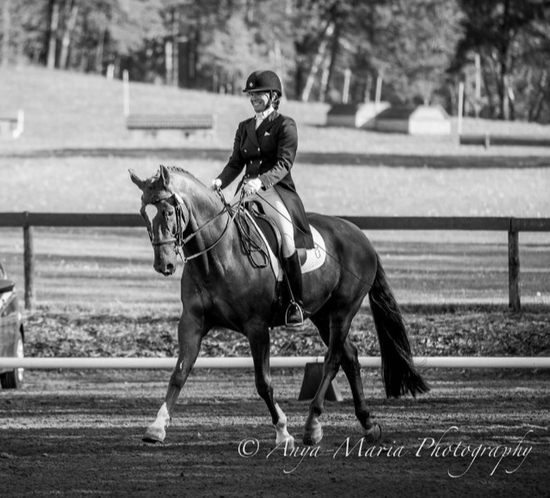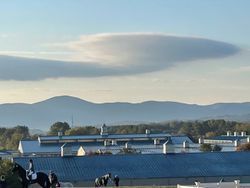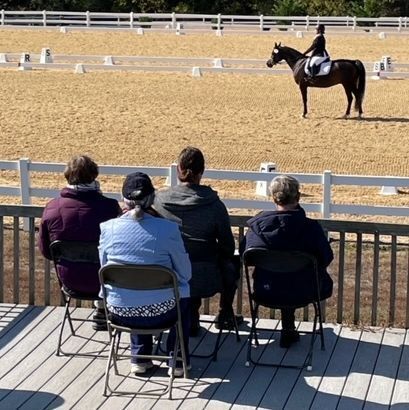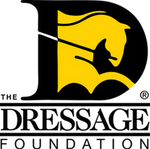2019 George Williams Young Professional Grant Fund Recipient: Heather Salden-Kurtz


L Program Experience
I was nervous and excited to participate in the USDF L Education Program, and thanks to TDF, I was able to join the program in 2022! I completed Part 1 of the program almost five years ago, but with a two-year delay due to Covid, I wasn't quite feeling at the top of my game. The program organizers and faculty were so amazing and supportive, and I left the program feeling invigorated and empowered.
The L Program is a wealth of knowledge, not just for the competitive rider, but also for the instructor/trainer and amateurs alike. I learned so much about developing my eye, using the correct terminology for each movement and level, and the expectation for each of the movements and levels. The program also goes into detail about the biomechanics of the horse and how the basics are the most important part of every moment - something we all need to be sure to acknowledge in our daily riding and training!

I read through the rulebook about a dozen times as well because the written test covers everything from equipment, biomechanics, and eliminations to freestyles and music, and more. I am glad that I did that, as I learned a lot of new rules and regulations that I did not know!
I also learned a great deal about how hard it is to judge! It gives me a new appreciation for all our judges and their expertise. There is so much to keep track of from the basics, criteria of the movement, rider position, accuracy, modifiers, and so much more. Plus, judges must make sure to stay on time! I am excited to continue practicing judging and continue my journey to becoming a judge. I feel it really helps me become a better test rider, as well as help my students develop the skills in their riding and showing.
I am so grateful that I was also able to meet colleagues from across the country. I've now made some great friends that I am blessed to have shared this experience with.
It was a wonderful educational experience, and I'm so glad I was able to participate. I am now an L Education Program graduate with distinction, and I can't wait to continue down this path!
Thank you, TDF for this amazing opportunity!
Training with Emily Miles and Jana Wagner
It was an eye-opening experience training with Emily Miles and her mother, Jana Wagner, at the magical Wally Woo Farm in La Cygne, Kansas, thanks to a grant from TDF’s George Williams Fund. I was fortunate to spend time riding, observing, and taking lessons during my time there. It was fun to see Emily and Jana work together and they are extremely open to explaining what they do, and even asked for my advice and suggestions. That’s perhaps the biggest lesson I could learn... the importance and value of having someone you trust to bounce ideas around with, and that there is always more to learn!
Emily and Jana seem to have an overarching philosophy of adjustability. It actually is funny to hear them bicker about whether an exercise does more to increase adjustability and flexibility of the shoulders or haunches but in the end it comes down to balance and adjustability... longitudinal and lateral.
They are precise and methodical in their approaches, and gave me a plethora of ideas to try with all my horses in training, both young and old. Seeing Emily ride her young stallions gave me something to aspire to, and I think it’s crucial as a trainer to witness first-class training to keep you “on your game.”
One exercise I found helpful was used to help a rider and horse understand the concept behind the trot half pass. They must understand the connection from the inside leg to the outside rein so the rider is able to maintain bend around the leg and effectively move the horse's shoulders on the line of travel.
To school half pass right in trot:
Tracking right, turn down the centerline and do a leg yield left (off the right leg.) Take care to ensure the horse maintains forward impulsion while pushing into and "filling up" the outside rein without falling through the outside shoulder. Upon reaching the rail, do a 10m circle right. Be sure to maintain the contact into the left rein while gently asking the horse for more flexion and bend around the inside leg. If able to maintain steady bend and connection into the outside rein, when you reach the wall again after your circle, maintain the bend and ask the horse to half pass right away from the wall. If the horse loses bend or loses connection into the outside rein, immediately leg yield a step or two away from the right leg until the outside rein connection is found again. Then continue the half pass right, or go back to the 10m circle right if you feel like the horse needs a better understanding of the bend and/or connection.
Emily and I both have coming 6-year-old horses, so starting and solidifying the flying changes was something we discussed at length. We all have our favorite techniques, but an exercise that Emily said she had rediscovered from an old trainer helped with the new outside rein half halt being effective:
Start in right lead canter. Tracking right, head down the long side of the arena. At V, do a half 10m circle right to the centerline and head towards A. Use the circle right to encourage the right hindleg to be active and the rider to really keep the right rein and shoulder (we tend to overturn our own bodies towards the direction of the new lead when in fact we should keep the new outside rein/shoulder/elbow/hip to allow the jump into the new lead). Keep the horse's shoulders turning a bit to the right, keep your own right side “on” (don’t let that right side get long) and as you feel them turning into right rein, slightly change bend and flexion and ask them to change to the left lead. They will be more inclined to change their lead, as the upcoming wall helps them get the idea of turning. The wall also helps keep them from getting too strong! Think it is the new outside rein that is critical... and hopefully the circle before helped establish that thought! Then proceed to do the same exercise the other direction by turning at P down the centerline and changing to the right. It is a great exercise to give them the right idea, but has its drawbacks as it can encourage the horse to be a bit crooked in the changes. So maybe not a great exercise to do forever.
Emily also was starting to introduce the idea of the canter pirouettes to Daily and Mio. Mio was having trouble knowing where to put his haunches! So we made it simple:
Start on a 10m circle in canter and really "own" the collected canter. You should be able to absolutely maintain the exact same collection, circle size, shoulder control, bend, tempo, connection and EVERYTHING ELSE to be able to make 3 or 4 identical circles without losing any of it! Then you start increasing difficulty not by making anything smaller... but by increasing adjustability. Start by bringing the horse's haunches slightly in on the circle and be sure that you don't lose any of the other pieces of the basics. Once the flexibility behind the saddle is accessible and the horse is comfortable then stay on the same circle and ride shoulder-in. Completely own it! Make sure it is shoulder in... not haunches falling out! Then gradually add more bend and make the circle slightly smaller, always ensuring that none of the pieces are lost. Every horse will be different in their ability to carry weight, don't overdo it but slowly progress to smaller circles, more bend, and more collection until you are able to turn it all the way around with ease!! Again, it always starts with correct basics!!
We also played around with a horse that is green to piaffe but has clear talent for it. He tended to get a little overzealous to go in the spot and lost his lift in the shoulder. So we tried to add adjustability of the shoulders:
Think a little shoulder in left, shoulder in right, or toggle back and forth a bit. A microscopic "turning" of the shoulders helps lift the shoulders in a big way, and the rider can do it so subtly that it's not even noticeable. The key was that the shoulder in comes not from pulling the neck in but really asking with the outside rein the shoulder to come up and in.
I enjoyed watching Emily ride but I did feel like she had the tendency to overbend one horse to the left. We discussed this on the way back to her house and it was interesting because Emily felt like generally she tends to over bend her horses to the right, and actually thought that she tends to teach and focus on the right bend too much. This horse specifically started to tilt when she asked for right bend so she was putting a bandaid on and keeping him straighter to avoid the tilt. The next day we worked him together again and through shoulder-in and turn on the forehand work we found more throughness where Emily could ask for a more honest right bend with no tilt!
It takes more than one lifetime to master dressage... so we all need to help each other in the one we have!
Thank you again to the George Williams Fund donors. The time I spent training with Emily and Jana was unforgettable and I feel so fortunate to have had the opportunity.
